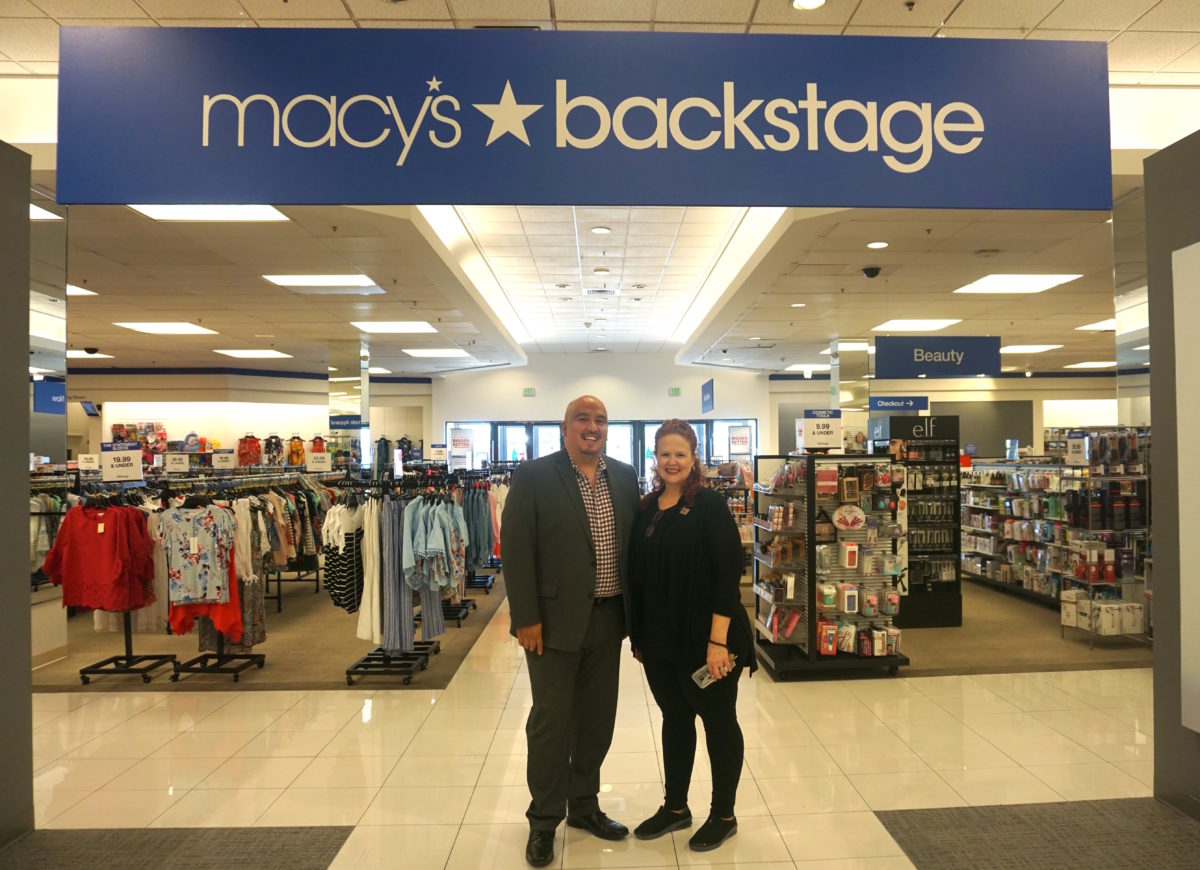
From left, Raul Diaz, Visalia Macy’s manager, poses with Debbie Vercher, manager of Macy’s Backstage. A Macy's Backstage at Fashion Fair Mall is coming next weekend. Photo by Edward Smith.
On June 16, Macy’s in the Visalia Mall officially unveiled its newest addition—the off-price retail brand Macy’s Backstage.
Macy’s celebrated the event with a DJ, photo booth and food vendors, as well as giveaways throughout the day and scratch-off tickets for the first 200 guests with prizes for the grand opening, according to Raul Diaz, store manager. The ribbon was cut at 9:50 a.m., shortly before the store opened.
Over the course of only a month, the clothing retailer transformed 14,000 square feet of its second floor to the company’s newest foray in the fight against slipping sales by introducing “the thrill of the hunt” into its shopping experience.
Off-price retailers often work by ordering clothes in volume and out-of-season to sell them at a deeper discount. In the case of Macy’s Backstage, a whole division with its own executives was dedicated to not only shipping but ordering as well. The project began in 2013 with 60 stores, according to Joy Deinla, media relations director at Macy’s and in 2018, it will open 100 new stores across the nation.
The store looks like a Ross or Marshalls with racks of discounted men and women’s clothing, footwear, handbags, even furniture and toys.
“For us, it’s about the thrill of the hunt,” said Diaz. There are brands familiar to Macy’s shoppers as well as brands exclusive to the Backstage division of the company that shoppers can search through to discover those rare finds.
“If there is a brand that matters most to this community, we have the opportunity to communicate that,” Diaz said.
This all comes as stores like Macy’s and JCPenney have been falling in terms of sales with the rise of online competition.
In fiscal year 2012, Macy’s generated $26.4 billion in revenue which represented 5.6 percent growth for the year, according to the stock analysis website, Revenuesandprofits.com. That percentage fell each year, bottoming out in fiscal year 2017 to $24.837 billion, down 3.7 percent compared to FY 2016, according to Business Wire.
“Department stores have not been performing well over the last five to seven years,” said Farla Efros, president at Illinois-based HRC Retail, who advises both healthy and unhealthy companies on business strategies. “It’s been a slow burn and has heightened over the last two to three years when debt repayment started to become an issue.”
Last year, Macy’s closed 70 stores across the country and has closed 156 locations since 2008, with another 11 coming closures announced for this year, according to a June 8 article in the Buffalo News.
Part of the problem has to do with competition. Beauty sections have been affected by competition from smaller and sleeker Ulta and Sephora brands while online shopping has affected all ends of the business.
“Because they’re not vertically integrated, they don’t really make that much of their own product,” Efros said. “All of that product is available on Amazon.”
To turn that around, the store hopes to use customer experience to bring people in. The ability to feel the clothes and hunt for bargains is an incredible magnet.
Being able to touch and feel the clothes is a major draw, said Diaz. Also, sifting through racks is a big part of getting people in the stores.
It’s about the treasure hunt. Efros calls it the “fear of missing out,” and its something that Costco and TJ Maxx have done incredibly, she said.
“I need to keep going back there because you never know what I can get,” Efros said. “I can get some incredible branded products for next to nothing.”
Macy’s hopes to bring that same sense of shopping urgency into its main-box stores. It began its off-price retail as stand-alone stores, but they see the store-within-a-store model as supplementing its main store, and according to Deinla, they’ve done so without cannibalizing sales from downstairs. They’ve seen an average of 7 percent growth in stores with a Backstage, said Deinla.
The off-price model is something familiar to Visalia. The TJ Maxx opened in 2013 and Home Goods opened at the end of 2015.
“Macy’s is also trying to reach that smart shopper,” said Gail Zurek, president of the Visalia Chamber of Commerce.
Coming to Visalia was a smart move in her eyes. The percentage of disposable income is high, said Zurek.
While the number of rooftops may be significantly fewer, retail sales per capita are much higher, with $14,744 in Visalia compared to $9,619 in Fresno, according to 2012 U.S. Census data.
The average median household income from data between 2012-2016 is $52,099 in Visalia compared to $45,963 in Fresno.
While smaller retailers may not have access to the ordering volume that can create the kind of sales that consistently draw in customers, there are three lessons to learn as the Macy’s story unfolds.
Department stores took on high interest loans that even improved sales are having trouble repaying. Efros cited Neiman Marcus who may have had a 6 percent comparative increase, but its high interest loans offset its ability to make money.
The second is real estate. “You don’t want to open too many stores,” Efros said. “You lose the customer experience that you had and you lose the control that you had as well.”
Lastly, as small businesses grow in this economy, they need to stay focused and understand who their customer is. “Sometimes you get executives come in with a different vision about who their shopper is,” said Efros. “That is what happened with JCPenney.”
One differentiating factor is that customer experience for small companies is more inherent in the business model.
“Smaller companies should focus on service and exclusivity versus price,” Efros said.








